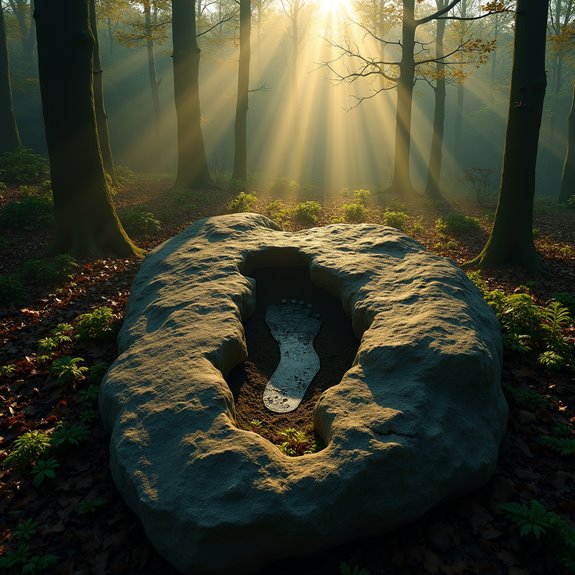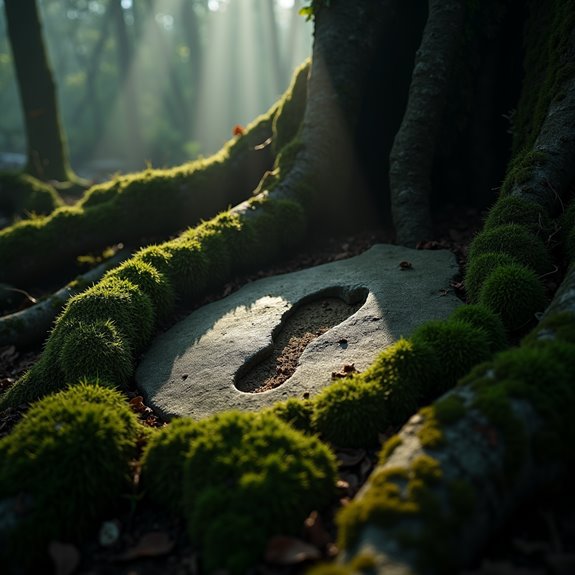Did the Devil Leave His Footprint in Massachusetts?
The legend of the Devil’s Footprint in Massachusetts weaves a rich tapestry of folklore and intrigue. With origins tracing back to Plymouth Colony, the stories captivate the imagination, mixing historical events with eerie tales of dark rituals. From sightings in Rehoboth to the snowy tracks found in Southbridge, the phenomenon raises questions. Are these marks of the supernatural, or can they be explained by more earthly means? The truth may reveal more about humanity’s struggle with good and evil.
Introduction

In the quiet landscape of Massachusetts, stories of the Devil’s Footprint have intrigued locals and visitors alike for centuries. This mysterious phenomenon, often described as a single large footprint etched into the earth, sparks curiosity and invites speculation. Tales vary, with some claiming the footprint is a remnant of the Devil himself, while others suggest more earthly explanations, such as a bear or an odd rock formation. Regardless of its origin, the footprint symbolizes the intersection of the mundane and the supernatural, kindling local folklore and fostering community conversations. From tales shared around campfires to academic investigations, the Devil’s Footprint highlights the rich tapestry of Massachusetts’ history and the enduring allure of its legends, keeping its enigmatic presence alive in modern times.
Plymouth Colony Folklore Roots

Long before the Devil’s Footprint captured the imagination of modern audiences, it found its roots in the rich folklore of Plymouth Colony. Settlers from England brought their beliefs in supernatural beings, including the Devil, who was often depicted as a trickster spreading mischief among the Puritans. Oral traditions and tales emerged, interweaving local landscape elements with eerie happenings. Stories of strange footprints in the snow and odd noises in the woods stirred curiosity and fear. These accounts served not only as entertainment but also as moral lessons, reminding the community of the ever-present battle between good and evil. As generations passed, the tales evolved, embedding themselves into the very fabric of Plymouth’s identity and shaping its cultural landscape.
Notable Cases or Sightings

Throughout the years, reports of strange footprints attributed to the Devil have surfaced, enchanting both locals and visitors alike. One notable case occurred in 1676 when a farmer in Rehoboth discovered peculiar footprints that stretched for miles and varied in size. This sighting stirred paranoia, leading many to believe the Devil roamed their towns. Another case happened in 1880 in Southbridge, where residents found a line of mysterious tracks in the snow, seemingly untouched by any other creature. People linked the footprints to a nearby church, causing a stir among the community. In all these instances, locals investigated with both fear and fascination, enthusiastic to understand the supernatural legend intertwined with their history and landscape.
Common Theories or Explanations
As rumors of the Devil’s footprint spread, various theories emerged to explain the mysterious tracks that haunted Massachusetts towns. Some locals believed it was a direct indication of the devil’s presence, attributing the footprints to dark rituals or supernatural events. Others suggested more mundane explanations, such as large animal tracks being misidentified. Skeptics argued it could be a practical joke, where someone carved a unique pattern in the ground to incite fear and excitement. Geological phenomena, like erosion or unusual soil patterns, also surfaced as possible accounts. All these theories reflect a mix of superstition and curiosity, showcasing how legends can thrive even in a modern context, as communities grappled with the enigmatic traces that seemingly defied rational understanding.
Frequently Asked Questions
What Regions in Massachusetts Are Most Associated With Devil Sightings?
In Massachusetts, regions like Salem, known for its witch trials, and urban areas like Boston often report sightings. Locals frequently recount encounters, sparking interest and legends that keep the stories alive through generations.
How Did Colonial Beliefs Shape These Devil Legends?
Colonial beliefs shaped devil legends by intertwining fear with religious fervor. Residents viewed the Devil as a tangible threat, transforming natural events and personal misfortunes into supernatural tales, reinforcing community morals through cautionary narratives surrounding evil.
Are There Any Modern Rituals Connected to These Legends?
Today, some practitioners still engage in rituals inspired by colonial legends, blending folk traditions and contemporary spirituality. They often seek to understand humanity’s duality, invoking symbols associated with the devil to explore deeper truths about themselves.
Have Any Scientific Studies Examined These Footprints or Sightings?
Various scientific studies have explored unusual footprints and sightings, focusing on environmental factors, natural phenomena, and psychological influences. Researchers aim to understand the origins, debunk myths, and explain how legends shape cultural perceptions.
What Local Events Celebrate the Devil’s Footprint Folklore Today?
Local events celebrating the devil’s footprint folklore include annual festivals featuring storytelling, reenactments, and art displays. These festivities engage the community, inviting participants to explore their history while enjoying local food and entertainment.


